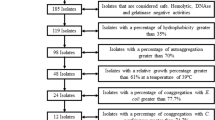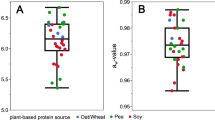Abstract
Three hundred and eighty three yeasts isolated from samples of unsulphited or sulphited sausages and skinless sausages and minced beef were characterized in detail.Debaryomyces hansenii was the most commonly isolated yeast from most samples followed byCandida zeylanoides andPichia membranaefaciens. The presence of sulphite in sausages did not appear to affect the numbers and range of yeasts present but did affect their relative proportions. A survey of one factory showed that meat intended for sausage production and equipment harboured the same range of yeasts that are found in the finished products.
Similar content being viewed by others
References
Abbiss, J. S. 1978. Enzyme-mediated changes in carbohydrate in the British fresh sausage. — Ph. D. Thesis, University of Bath.
AboukheirS. and KilbertusG. 1974. Fréquence des levures dans les denrées alimentaires à base de viande. — Ann. Nutr. Aliment.28: 539–547.
Anonymus. 1962. The preservatives in food regulations. Statutory Instrument 1962, No. 1532. —London H.M.S.O.
AyresJ. C. 1960. Temperature relationships and some other characteristics of the microbial flora developing on refrigerated beef. — Food Res.25: 1–18.
BanksJ. G. and BoardR. G. 1981. Sulphite: the elective agent for the microbial associations in British fresh sausages. — J. Appl. Bacteriol.51: ix.
BanksJ. G. and BoardR. G. 1982. Comparison of methods for the determination of free and bound sulphur dioxide in stored British fresh sausage. — J. Sci. Food Agric.33: 197–203.
BeechF. W., DavenportR. R., GoswellR. W. and BurnettJ. K. 1968. Two simplified schemes for identifying yeast cultures. p. 150–175.In B. M.Gibbs and P. A.Shapton (eds), Identification Methods for Microbiologists, The Society for Applied Bacteriology, Technical Series, No. 2, Part B. — Academic Press, London.
BowenJ. F. and BeechF. W. 1967. Yeast flora of cider factories. — J. Appl. Bacteriol.30: 475–483.
Brown, M. H. 1977. The microbiology of the British fresh sausage. — Ph. D. Thesis, University of Bath.
DowdellM. J. and BoardR. G. 1968. A microbiological survey of British fresh sausage. —J. Appl. Bacteriol.31: 378–396.
DowdellM. J. and BoardR. G. 1971. The microbial associations in British fresh sausages. —J. Appl. Bacteriol.34: 317–337.
DrakeS. D., EvansJ. B. and NivenJrC. F. 1958. Microbial flora of packaged frankfurters and their radiation resistance. — Food Res.23: 291–296.
DyettE. J. and ShelleyD. 1966. The effects of sulphite preservative in British fresh sausages. — J. Appl. Bacteriol.29: 439–446.
Empey, W. A. and Scott, W. J. 1939. Investigations on chilled beef. Part I. Microbial contamination accquired in the meat works. — Comm. Sci. Ind. Res. Australia, Bulletin No. 126.
Fielder, R. J. 1983. The microbiology of the British fresh pork skinless sausage. — University of Bath, Report No. 555.
GardnerG. A. 1980a. Microbiology of processing bacon and ham. p. 129–178.In M. H.Brown (ed.), Meat Microbiology. — Applied Science Publishers Ltd, London.
GardnerG. A. 1980b. The occurrence and significance ofPseudomonas in Wiltshire bacon brines. — J. Appl. Bacteriol.48: 69–74.
GraumlichT. R. and StevensonK. E. 1978. Recovery of thermally injuredSaccharomyces cerevisiae: effects of media and storage conditions. — J. Food Sci.43: 1865–1870.
HartmanP. A., HartmanP. S. and LanzW. W. 1975. Violet red bile 2 agar for stressed coliforms. — Appl. Microbiol.29: 537–539.
Hessel-SchmalfuszI., SmithM. Th. and HadlokR. 1976. Hefen und Fleisch: Vorkommen, Systematik und Differenzierung. — Fleischwirtschaft56: 379–384.
HolwerdaK. 1952. The importance of the pH of culture media for the determination of the number of yeasts and bacteria in butter. — Neth. Milk Dairy J.6: 36–52.
IngramM. 1952. Internal bacterial taints (bone taint) or souring of cured pork legs. — J. Hyg.85: 211–218.
IngramM. 1958. Yeasts in food spoilage. p. 603–633.In A. H.Cook (ed.), The Chemistry and Biology of Yeasts. — Academic Press Inc., New York.
JayJ. M. and MargiticS. 1981. Incidence of yeasts in fresh ground beef and their ratios to bacteria. — J. Food Sci.46: 648–649.
JuvenB. J., KannerJ. and WeisslowiczH. 1978. Influence of orange juice composition on the thermal resistance of spoilage yeasts. — J. Food Sci.43: 1074–1076; 1080.
KendereskiS., DordevičJ. and JaksevičJ. 1972. Occurrence of yeast cells on meat, in curing pickle and meat products and the effects on flavour of the finished product. — Tehnol. Mesa13: 66–73.
KingJrA. D., PontingJ. D., SanshuckD. W., JacksonR. and MiharaK. 1981. Factors affecting death of yeast by sulphur dioxide. — J. Food Prot.44: 92–97.
KühlH. 1910. Ueber ein Vorkommen von Hefe auf schmieriger Wursthaut. — Centralbl. Bakteriol. Parasitenkd. Infektionskr. Abt 1:54: 5–6.
LawrieR. A. 1974. Meat Science, Second edition. — Pergamon Press, Oxford.
LeaC. H. 1931a. Chemical changes in the fat of frozen and chilled meat. Part I. Frozen mutton and lamb. — J. Soc. Chem. Ind., London50: 207T-213T.
LeaC. H. 1931b. Chemical changes in the fat of frozen and chilled meat. Part II. Chilled beef. — J. Soc. Chem. Ind., London50: 215T-220T.
Leads, C. S. 1979. The organoleptic stability of British fresh pork sausages. — Ph. D. Thesis, University of Bath.
LeistnerL. and BemZ. 1970. Vorkommen und Bedeutung von Hefen bei Pökelfleischwaren. —Fleischwirtschaft50: 350–351.
LodderJ. (ed.) 1970. The Yeasts—A Taxonomic Study, Second edition. — North Holland Publ. Co., Amsterdam.
MosselD. A. A., Kleynen-SemmelingA. M. C. and VincentieH. M. 1970. Oxytetracycline-glucose-yeast extract agar for selective enumeration of moulds and yeasts in foods and clinical material. — J. Appl. Bacteriol.33: 454–457.
MrakE. M. and BonarL. 1938. A note on yeast obtained from slimy sausage. — Food Res.3: 615–618.
NottinghamP. M. 1982. Microbiology of carcass meats. p. 13–65.In M. H.Brown (ed.), Meat Microbiology. — Applied Science Publishers Ltd, London.
PearsonD. 1970. The Biochemical Analysis of Foods, Sixth edition. — Churchill, London.
PutH. M. C. and DeJongJ. 1980. The heat resistance of selected yeasts causing spoilage of canned soft drinks and fruit products. p. 181–213.In F. A.Skinner, S. M.Passmore and R. R.Davenport (eds), Biology and Activities of Yeasts, Society of Applied Bacteriology Symposium Series No. 9. — Academic Press, London.
PutH. M. C., DeJongJ. and SandF. E. M. J. 1977. The heat resistance of ascospores ofSaccharomyces cerevisiae strain 195 andSaccharomyces chevalieri strain 215, isolated from heat preserved fruit juice. p. 545–563.In A. N.Barker, J.Wolf, D. J.Ellar, G. J.Dring and G. W.Gould (eds), Spore Research, 1976, Vol. 2. — Academic Press, London.
ScottW. J. 1936. The growth of micro-organisms on ox muscle. The influence of water content of substrate on rate of growth at-1°C. — J. Counc. Sci. Ind. Res.9: 177–190.
SneathP. H. A. and JohnsonR. 1972. The influence on numerical taxonomic similarities of errors in microbiological tests. — J. Gen. Microbiol.72: 377–392.
SnijdersJ. M. A. and GeratsG. E. 1976. Hygiene bei der Schlachtung von Schweinen IV. Bakteriologische Beschaffenheit der Schlachttierkörper während verschiedener Schlachtphasen. —Fleischwirtschaft56: 717–721.
Van derWaltJ. P. 1970. Criteria and methods used in classification. p. 34–113.In J.Lodder (ed.), The Yeasts—A Taxonomic Study, Second edition. — North Holland Publ. Co., Amsterdam.
WalkerH. W. and AyresJ. C. 1970. Yeasts as spoilage organisms. p. 463–527.In A. H.Rose and J. S.Harrison (eds.), The Yeasts, Vol. 3. Yeast Technology. — Academic Press, London.
WickerhamL. J. 1951. Taxonomy of Yeasts. Technical Bulletin No. 1029. — United States Department of Agriculture, Washington, D. C.
ZivanovičR. and RističD. 1974. Finding of yeasts in tea sausage during their technological process. — Tehnol. Mesa15: 51–52.
Author information
Authors and Affiliations
Rights and permissions
About this article
Cite this article
Dalton, H.K., Board, R.G. & Davenport, R.R. The yeasts of British fresh sausage and minced beef. Antonie van Leeuwenhoek 50, 227–248 (1984). https://doi.org/10.1007/BF02342134
Received:
Issue Date:
DOI: https://doi.org/10.1007/BF02342134




